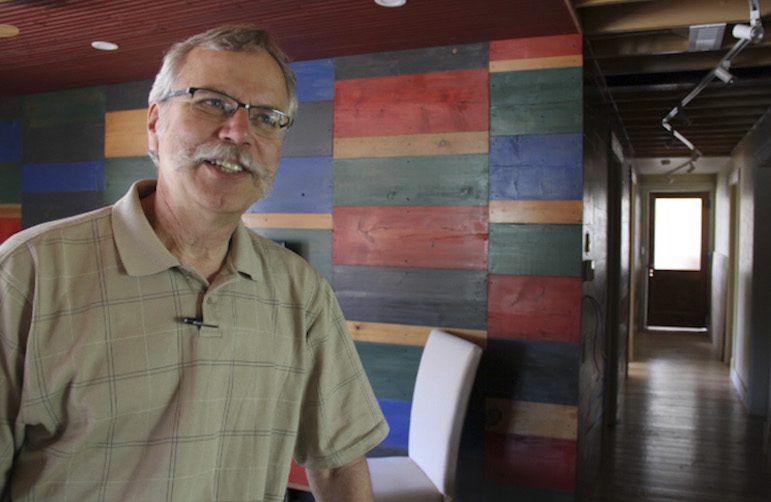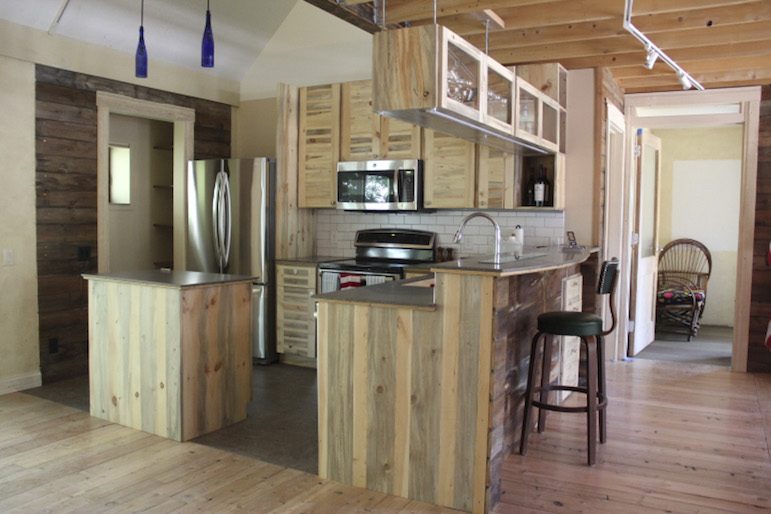Off-the-grid house nearly done, tours offered this week

Ed Kemmick/Last Best News permalink
Randy Hafer calls the living room wall of his "Urban Frontier House" the "wall of many colors." It is made of scrap shelving painted with all the colors appearing elsewhere in the house.

Ed Kemmick/Last Best News permalink
The house is lighted with DC microgrid-powered LED lights, including this line of lights in a stairwell.
Ed Kemmick/Last Best News permalink
Because the house is so energy-efficient, a relatively small solar array, seen from a patio outside the house's third-story crow's nest, is relatively small.
Ed Kemmick/Last Best News permalink
Water for the house is collected from the roof and stored in six 1,500-gallon tanks in the basement.

Ed Kemmick/Last Best News permalink
The kitchen features salvaged wood and energy-efficient appliances.
Walking up to his new house a few blocks from downtown Billings, Randy Hafer apologizes for the tall weeds in the dirt surrounding the home.
“The focus has not been on the outside of the house,” he says.
That’s understandable. On the inside, the house is so advanced that there is nothing like it in Montana, and not many like it in the whole country.
Hafer calls it the “Urban Frontier House,” designed to be entirely off the grid, meaning it will use no more water or energy than it is able to generate on-site. There are plenty of off-the-grid houses in the hinterlands of Montana, but this will be the first in an urban setting, and with all the comforts of a typical home.
And so perhaps it’s no surprise, either, that Hafer and his wife, Janna, were moving the last of their furniture into the house on Thursday, more than a year behind schedule.
House tours featured during symposium
Randy Hafer will be one of the featured speakers at a two-day Innovate Montana Symposium sponsored by Big Sky Economic Development next week.
The event, set for Wednesday and Thursday at the Crowne Plaza Hotel, will be the second Main Street Montana Project and will be hosted by Gov. Steve Bullock. The symposium will focus on highlighting change and innovation among small businesses in Montana.
As part of the symposium, tours of the Hafers’ “Urban Frontier House” will be given Wednesday morning. Tours will depart from the Northern Hotel. To sign up, write to Melanie@bigskyeda.org.
“As we expected,” Randy Hafer said, “there are some bugs to work out.” Many of those bugs stem from the fact that “nothing in here was familiar to anybody,” Hafer said, necessitating no end of tinkering, figuring and creative problem-solving, all of which were time-consuming.
Other delays have been related to Hafer’s quest for certification through three different programs. For starters he wants to achieve LEED Platinum status for the house, meaning it would have to meet the highest standards set by the U.S. Green Building Council.
He also wants to be certified by the Passive House Institute and to meet the Living Building Challenge, which would earn the house certification from the International Living Future Institute in Seattle.
That last one has the most rigorous standards. If you don’t meet certain LEED standards, you are docked points. If you don’t meet all the standards set for the Living Building Challenge, you don’t receive certification.
And the most difficult part of that challenge has been finding the proper building materials.
“Trying to source materials that don’t have toxic crap in them? That’s hard,” Hafer said, but it is absolutely mandatory.
All the new lumber had to be approved by the Forest Stewardship Council, and it had to be obtained from as nearby as possible. In cases where such lumber can’t be used or is unavailable, salvaged wood is acceptable.
Hafer, the owner with Janna of High Plains Architects, used a combination of FSC lumber and salvaged materials. Some of the wooden support columns were salvaged from the old Cobb Field ballpark in Billings, and many of the doors are from the Oliver Building at North Broadway and First Avenue North.
Several big beams came from the demolition of a grade school in Lame Deer, which just happened to be the right dimensions, and which were available in almost exactly the right quantity.
“So, we had some things go our way,” he said.
Likewise, a friend on the Hi-Line gave the Hafers some barn wood that was used for flooring in the master bedroom and a bedroom across the hall—again in almost exactly the right quantity. Some corral boards from the same Hi-Line farm became stairs.
The “wall of many colors” in the living room and an adjoining hallway had been shelving in a downtown building. Because the pieces were in such a variety of sizes that joints could never be made to match, the pieces were laid in as if part of a puzzle, then painted with all the different colors left over from painting other parts of the house.
With 2,400 square feet of living space, the house will be heated and cooled passively, ventilated in the summer by opening windows and solar-powered skylights, assisted by large, completely noiseless bamboo ceiling fans.
In the winter, fresh, warm air will flow through the house after being heated by the sun in the 300-square-foot garden room that sits between the house and the two-car garage. Circulation will be aided by a heat-recovery ventilator.

Ed Kemmick/Last Best News
The “Urban Frontier House” sits at North 23rd Street and Seventh Avenue North.
Power is generated by a 2.2-kilowatt solar array and a vertical-axis wind turbine on the corner of the property. Heating and cooling are efficient and require few inputs because the house sits inside a super-insulated envelope of overlapping structural insulated panels.
The house is also equipped with its own DC microgrid that powers all-LED lighting as well as some equipment and appliances. The Hafers plan to stay connected to the city power grid for a year, to make sure their calculations are accurate and the house produces enough electricity.
All the Hafers’ water will come from rainwater collected off the roof and stored in six 1,500-gallon tanks in the basement. Gray water—from sinks and appliances—will be stored in tanks totaling 1,500 gallons and will be used for irrigation, clothes washing, toilet flushing and dish washing.
Toilet waste will be processed in a huge composter in the basement.
Meanwhile, High Plains Architects is working with students at Rocky Mountain College to design and install sensors—some of them already in place—that will monitor air quality, temperatures, humidity and levels of carbon dioxide, as well as water and energy performance.
Eventually, Hafer said, it will be possible to make the entire system automatically responsive to the needs of the occupants and to outdoor weather conditions. Insulated blinds, for instance, could be automatically raised or lowered to retain heat in the winter or keep hot air out in the summer.
There has been almost no construction waste besides scrap lumber, which Hafer will burn in a backyard fire pit.
Hafer said he has worked on the house after work and on weekends, almost every day since November, joined on most of those days by Janna. He said there have been more than a few nights when they would knock off at 11 p.m. and finally have dinner together.
They had their first official family gathering on July 4. It is possible that by next July 4 the house will celebrate its independence from all outside utilities.
More information: For a more detailed look at the house, and the process of building it, go to the High Plains Architecture blog.
Comments
comments









Pingback: Urban Frontier House wins LEED Platinum certification | Last Best News